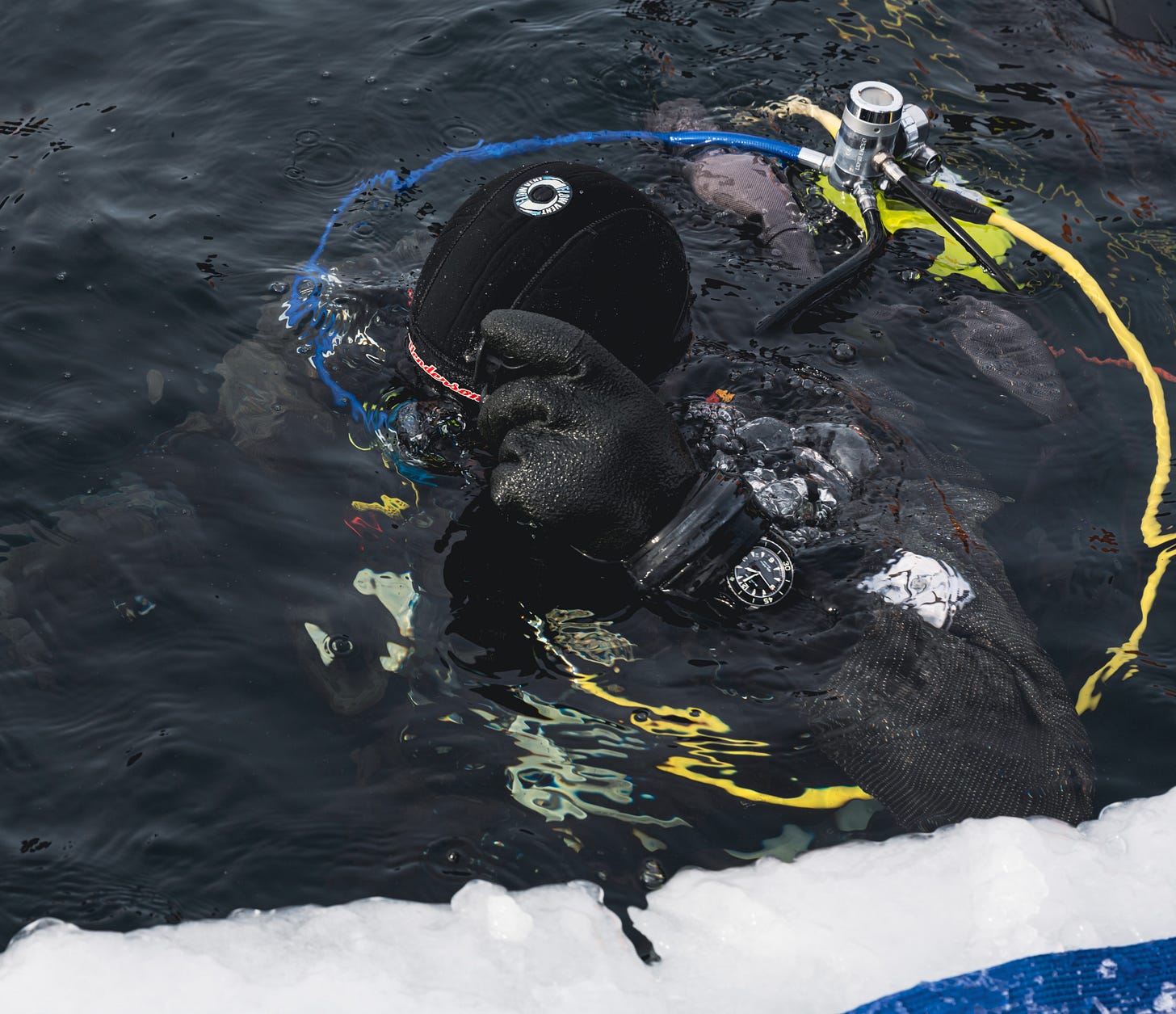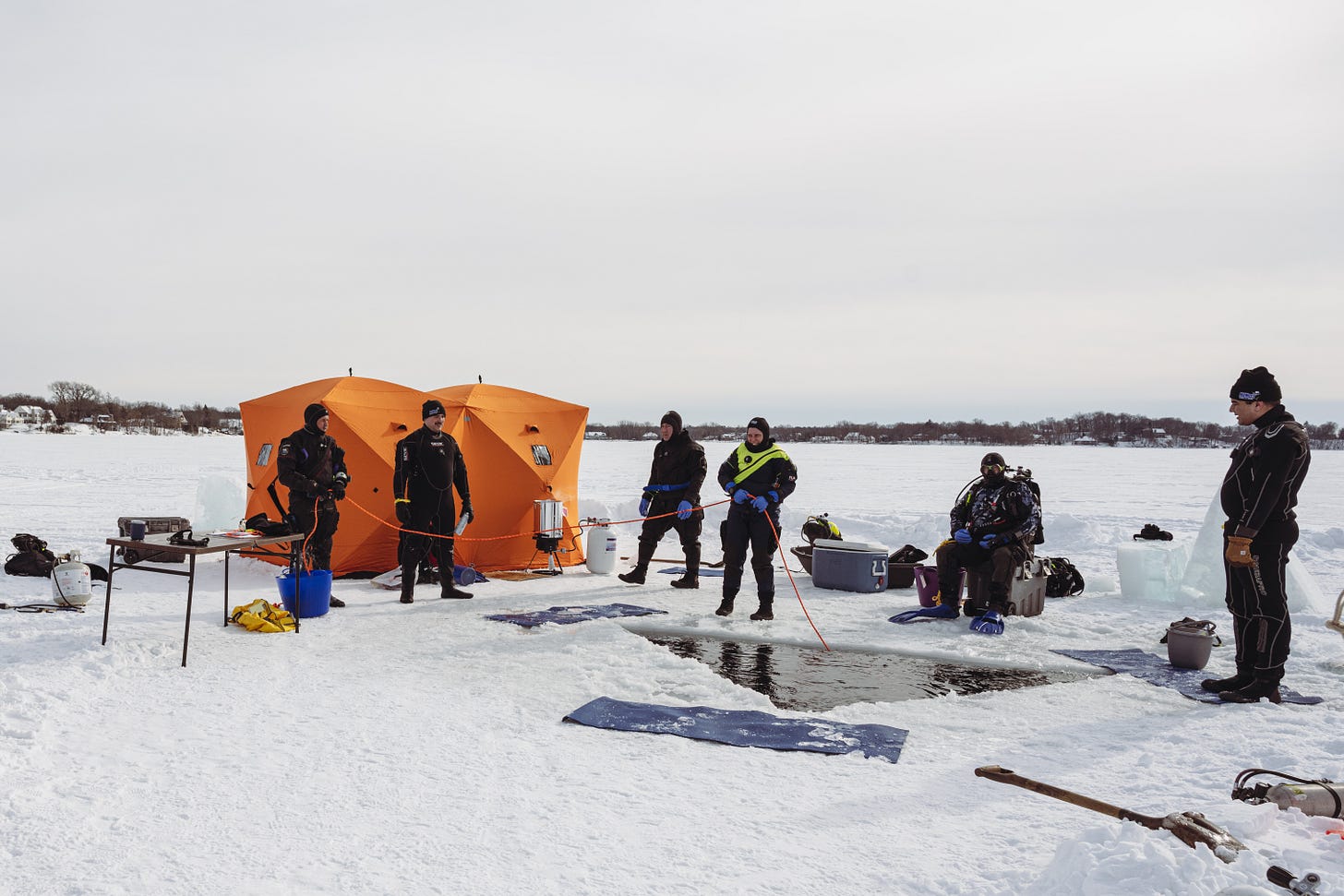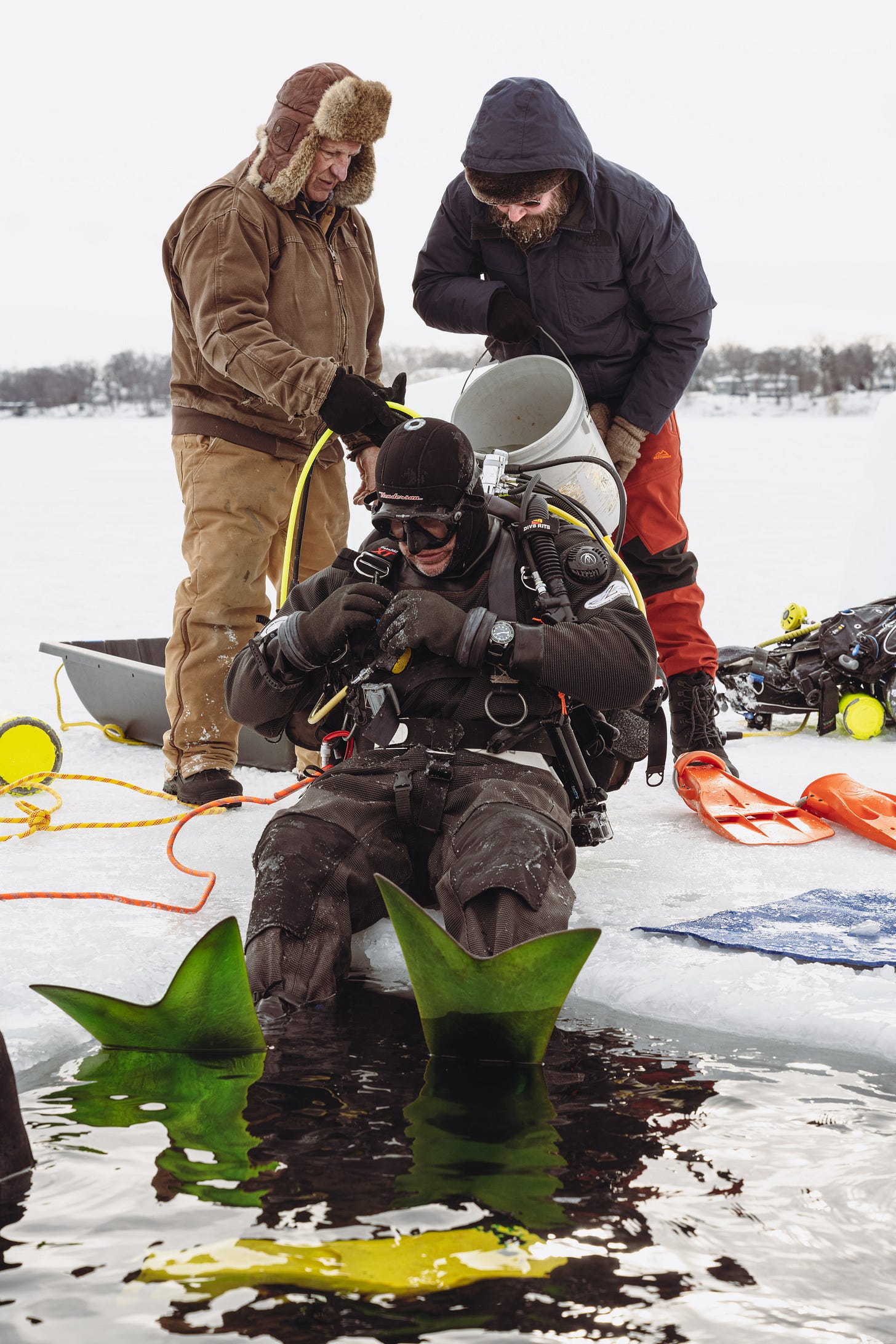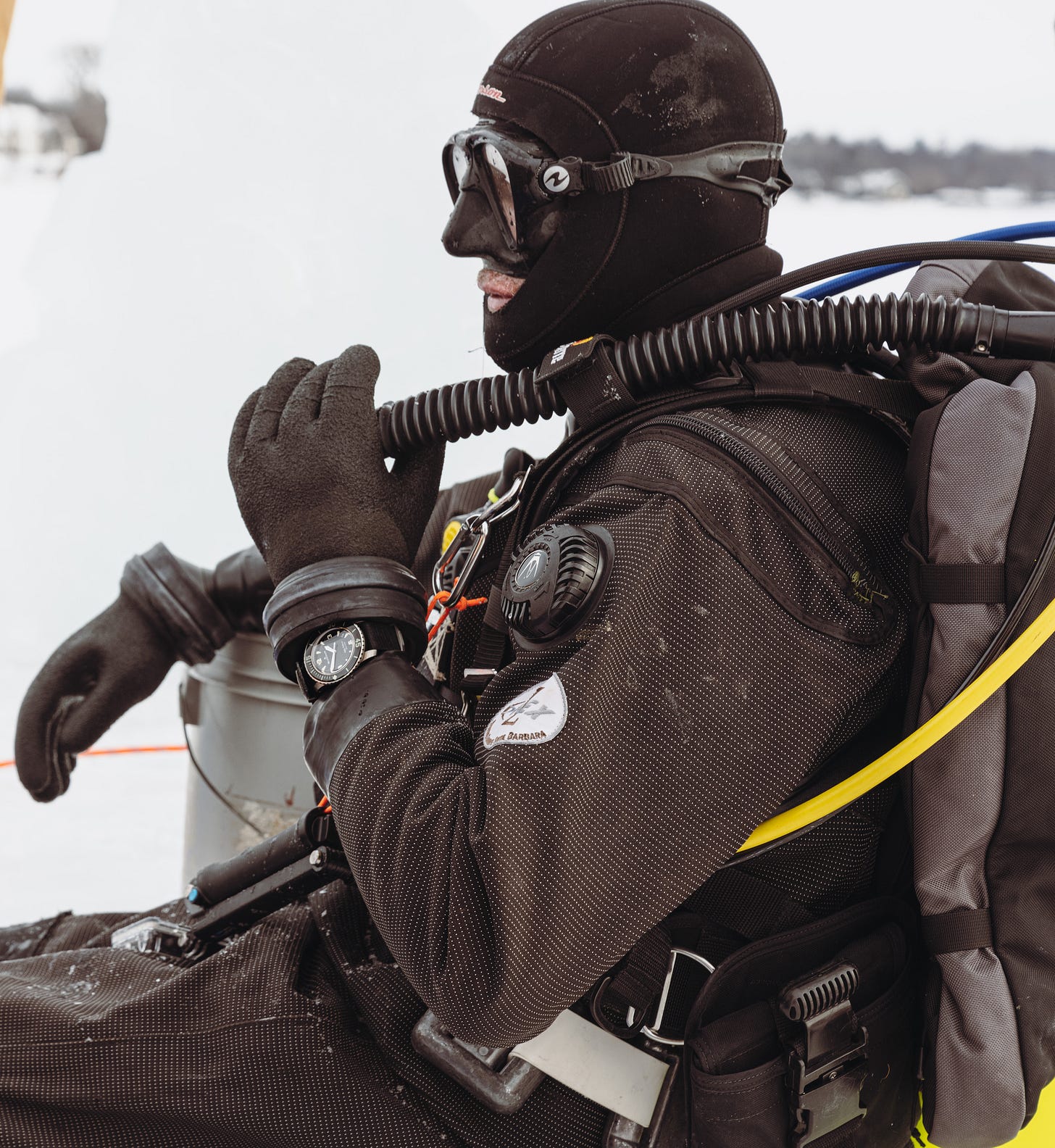Once More, Under the Ice
Answering the question, "why?"
Last week I gave some advice to divers: always take your safety sausage. But I need to amend that, because there’s one place an inflatable marker buoy won’t help you: under the ice. So when I sat perched on the edge of the triangular hole in the middle of frozen White Bear Lake last weekend, my safety sausage was not clipped to my harness. It was back home in the basement. Don’t worry, I wasn’t throwing caution to the wind. If I drifted away on a current, I had a thick nylon rope firmly attached to me with a locking carabiner. There wasn’t a boat in sight anyway.
Yes, I did it again. It’s said that the body has a short memory for pain, and that must also be true for all the hard work and discomfort that goes with ice diving. So there I was, stomping my feet in 5 degrees Fahrenheit (minus 15 Centigrade) air on a windblown moonscape waiting my turn to kick around under a foot of frozen water. Why do I do this? Why do I get so excited for ice diving as the date gets closer, even though I know it involves hours of work for a quarter of an hour underwater? Gishani tells me it’s so I can punch my “adventure card” for another year, and she’s partly right.
I’ve come to the realization that one of the appeals of scuba diving for me is that it’s an accessible way to do something extreme, something not many others do, something to talk about. Even the most mundane diving in unremarkable places renders stories that leave others amazed and make me seem far more interesting and adventuresome than I really am. I love people’s reactions: “You dove where?” “Isn’t it scary?” “Isn’t it cold?” “I didn’t know you could dive there!” It is also a confidence booster to do something entirely optional, potentially dangerous, and that requires a level of self sufficiency. If I can muster the courage to dive under the ice, well then anything—public speaking, making a career change, getting a tattoo—should be a lot easier.
I remember when I first took up diving, I just wanted to do it as much as possible. I dove in flooded quarries and weedy lakes. One summer after I got certified, I joined a couple of eccentric old divers setting off in a fishing boat in White Bear Lake (yes, the same one that was frozen this past weekend) to look for old soda bottles. It was dangerously shallow; I could hear outboard motors buzzing just feet over my head in the silty water. It was warm—disgustingly warm—and I saw nothing but weeds and castoff trash, but we dove for hours, popping up occasionally to toss another bottle into the boat. This was full on “Detectorists” level of nerdery.
Another year, I was on a work trip in Boston and decided to pack along my gear and join a local club for their weekly lobster dive in Boston Harbor. Yes, polluted, murky Boston Harbor. Big airliners buzzed us, descending into Logan Airport, as we slipped into the choppy grey water. These divers were a committed bunch, with their specialized tools for levering the stubborn “bugs” out of their rocky hiding places, and their metal rulers for measuring their quarry (only a minimum size could be kept). I saw my very first shark there. Technically it was a dogfish, but still a member of the shark family and looked like a miniature version of something far more scary and dangerous. It flitted around us, in and out of the gloom. I remember the next day at the office thinking how much richer life was with those memories filed away to conjure up in a boring meeting.
2023 was the tenth anniversary of my first ice dive. The initial apprehension is long gone, replaced by a wisdom gained by doing it a few times. The majority of an ice diving day is spent on the surface, waiting around. I got to White Bear Lake around 8:30am. I wasn’t in the water until 2:00pm. There was a tent to erect, kerosene heaters to get going, water to heat (for thawing gear and gloved hands), tanks to set up, a hole in the ice to cut, snow to shovel, a drysuit to shimmy into, and so on. I’ve learned the importance of dressing right, and I suppose it’s the same principles as those practiced by polar explorers. Layers, 800-fill down, Vaseline on the cheeks and nose to ward off frostbite, boots a size too big so you can wiggle your toes, cheap hardware store leather mittens, and a waterproof duffel to store my gear in, because other divers are careless and sloppy when they don and doff their snowy clothes and wet gear inside the tent. And then there’s the dive gear itself.
Ice diving is rife with equipment issues. Addressing them adds hours to the day and ends dives before they begin for some people. The main concern is free-flowing. Here’s a little science for you (from an English major, so forgive any simplification). A cylinder of air is around 3,000psi (200 bar) of pressure. The regulator’s job is to decrease that to 150psi in the hose when you inhale. That tremendous drop in pressure causes a rapid drop in temperature, just like when you spray an aerosol can, the metal gets very cold. Any moisture in the tank’s air will turn to ice crystals inside the regulator, keeping its valve seat from sealing properly. This leads to the air hissing out quickly. The irony is, though ice diving is cold, it’s warmer in the water (above freezing by definition!) than on the surface. So the key to avoiding this problem is to open the tank valve slowly, try to keep the tank and valves off the cold snow and ice as much as possible, and never—NEVER—breathe off your mouthpiece until you’re underwater.
I see a lot of divers hook up their tanks on the ice, after they’d been lying on the snow for hours, then test it all out by puffing all the valves—their buoyancy device, their mouthpieces, etc.— which then results in a panicked scramble to stem the loss of all that breathing gas. Regulators are often “cold water sealed” but that’s only half the battle. I saw several divers sitting on the edge of the hole, all suited up, only to have to abort the dive due to chronic free-flow. It’s also discomforting. The sound of your air hissing away plays with the brain until you no longer want to even consider going underwater.
My method was this: set up my tank in a warm house before leaving, turn on the air and puff some into the hoses, then shut off the valve and don’t touch it again until time to dive. Then, before diving, I slowly opened the tank valve, and when I jumped into the ice hole, I stuffed the regulator in my mouth and took my first breath as my head went under the surface. No free-flow. The only issue I experienced was upon surfacing after the dive. As I came up through the slush, I inflated my buoyancy wing and it didn’t stop. Fortunately, these devices have a “burp” valve that dumps excess pressure so the bladder doesn’t explode. My inflator valve had become frozen open. Of course, it wasn’t a problem since I was done with my dive. Had it happened underwater, I’d have been pinned against the ice sheet but then typically free-flows don’t happen underwater because it’s above freezing.
You’d hope that after waiting several hours, watching other divers struggle in and out of the water, some successful, others bitterly disappointed or simply bitterly cold, that my dive would be amazing. But by the time I got in, the silt on the shallow lake bed had been stirred up to the point of almost zero visibility. It was like swimming inside a ping-pong ball—white and cloudy in every direction—except up. If I needed to orient myself, I simply lifted my head and saw the glow of the dim winter sun through the ice sheet above. Globules of exhaled air danced around, as if alive and trying to escape, dark shapes against the bright ice. I was tied into the tender rope with one other diver whose name I never even learned. We swam, blind, for about 12 minutes until we reached the end of our 75-foot tether, at which time I felt three tugs on the rope. Time to go back. I repeated the signal by tugging three times and our tender reeled us in, perhaps a bit faster than I’d liked. We rose and flew through the water, right up against the smooth ice. I put my hand on it to keep my head from knocking, until the hole came into view. Then it was over: 13 minutes in total.
The aftermath of an ice dive is anticlimactic. The buzz of risk and adventure is gone, the chill really sets in, and all that’s left is to pry oneself out of a stiffening, frost covered suit and getting into dry clothes as quickly as possible. My drysuit leaked a little— it always does. This time, I suspect the neck seal was a bit too loose due to my recent weight loss. My chest and crotch were damp, though thanks to layers of wool and fleece, I wasn’t cold. I changed back into my down pants and jacket and oversized boots and mittens and packed all my gear away, before setting off to find a hot cup of tea.
Again, the question arises: why? Why spend an entire day in truly Arctic weather for so little time diving? The answer, I’ve decided, is because the whole day is an adventure, not just the diving. It is the camaraderie of these like-minded people who come out to do the same. We all have visions of clear water, blue ice, leopard seals offering up dead penguins to us, and maybe an orca swimming past. The reality is, it’s all about the challenges and the triumphs, big and small, that result: using plastic Ziploc bags and duct tape as makeshift windows to seal up our leaky tent, toes that stay (reasonably) warm, making new friends, thawing a frozen regulator, sourcing a lighter to ignite our stove to boil water, and the stories to tell in the pub afterwards. My gear is thawed and dried out now, but I’ve already got my eye on next year’s ice dive. The organizers have promised a bigger, even better event for 2024, with even a night dive under the ice planned. Count me in.
In the meantime, next week I’m off to dive in a decidedly warmer place: Rangiroa, on one of the biggest coral atolls in French Polynesia. After this past weekend, it’s going to feel well earned. I’ll be taking next week off from Substack, but back the following week with very different dive stories and more colorful photos. Til then, stay warm!






It’s way beyond me but love the stories after! Dad
Another amazing adventure Jason. One of my goals this year is to get SCUBA certified. Hopefully our paths will cross topside and beneath the surface soon.